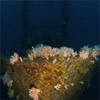 |
|
| 17 Lost Souls • Discovering the Wreck of the Fairwind |
| Text and photography by DamienSiviero |
| Upright and proud with her hull relatively intact, the Fairwind appeared on the sandy bottom as soon as we got in range. The forward and rear king posts towered over the site, protruding about 30 feet above the wreck. This inspiring view made the Fairwind reminiscent of the Truk Lagoon maru-style ships, and is something very distinct in Australian waters |
|
|
|
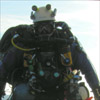 |
|
| 2010 North East Wreck Week |
| by Brian Matthewman |
| There are over 1500 unknown wrecks and underwater obstructions listed in the hydrographic charts of the British Isles. It is no wonder that there are some nice wrecks to be found every year. But the key to finding great wrecks is not just diving skills and good luck; i |
|
|
|
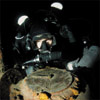 |
|
| All Hands Lost • Kamloops • Isle Royale • Lake Superior |
| Text by Curt Bowen • Photography by Mel Clark and Curt Bowen |
| Near gale force winds smashed wave after wave across the decks of his ship, the Kamloops. The 250-foot, 2,226-ton, iron cargo ship was in a battle for her life, and all aboard knew that only his skill, and the grace of God, stood between them and the ravenous waters of Lake Superior. |
|
|
|
 |
|
| B-29 Super Fortress - Lake Mead |
| Text and photography by Mel Clark |
| Lake Mead holds many sunken treasures for the adventure minded scuba diver, including a PBY Mariner, Wreck Alley, and the B-29 bomber. The lake has many great technical dives that could keep an avid diver content for days or even weeks. The “crown jewel,” and the most fiercely protected dive site in the lake, is the B-29 |
|
|
|
 |
|
| Bikini Able - Submerged Nuclear Aftermath |
| Text and photography by Pete Mesley |
| The Saratoga, first commissioned in 1925, was a 40 thousand ton, 268 meter long aircraft carrier. She did tours in the Pacific, Nicaragua, San Diego, Hawaii, Guadalcanal and Marshall Islands. In 1944 she was commissioned to train aviators for night operations. In Feb. 1945 she carried night fighters during the Iwo Jima invasion and raids on the Japanese home islands. |
|
|
|
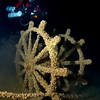 |
|
| Carl D. Bradley |
| Text and photography by Mel Clark |
| The Carl Bradley was the largest steel freighter on the great lakes in 1957 at a length of 639 feet. Ironically enough, the year she sank, 1958, was the same year the Edmund Fitzgerald (729 feet) was put into service and took the largest freighter of record from the Bradley. |
|
|
|
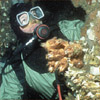 |
|
| Diamond Knot Wreck • Jewel of the Emerald Sea |
| Text and photography by John Rawlings |
| The 5,525-ton freighter carried more than seven million cans of salmon from Bristol Bay, Alaska. Although the fog was particularly thick this night, the Diamond Knot was not unaccustomed to hazardous voyages. |
|
|
|
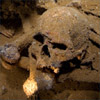 |
|
| Ghost Destroyer of Truk Lagoon |
| Text and photography by Leigh Bishop |
| The Japanese destroyer Oite is certainly one wreck that is often missed by visiting divers if only due to its location and depth which in around 210-220ft of water is much deeper than the majority of the other wrecks and some considerable distance away for the bulk concentration of tourist wrecks. |
|
|
|
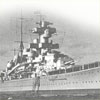 |
|
| Hitlers Blucher |
| Text and photography by Sten Stockmann |
| Hitler’s plan for conquering Norway was simple. The heavy cruiser Blücher would sail into the Oslo harbor, turn its cannons against the royal palace, and Norway would surrender. The occupation forces would then take care of the rest. But things would not go fully as planned... |
|
|
|
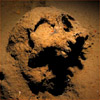 |
|
| HMS Repulse |
| Article by Greg Doyle |
| HMS Repulse, the British battle cruiser lost in the early days of the Pacific war to a combination of Japanese tactical superiority and the British Navy’s ignorance of the potential of aerial warfare against ships. |
|
|
|
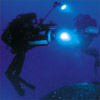 |
|
| HMS Victoria - Admiral Tryon’s Blunder |
| Text and photography by Vic Verlinden |
| At a speed of nine knots, the two vessels, each weighing 10,000 tons, were now turning towards each other. For several of the officers-in-command, it became crystal clear that a collision was inevitable. |
|
|
|
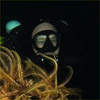 |
|
| HMCS Cape Breton |
| Text and photography by John Rawlings |
| HMCS Cape Breton is a veteran of the Second World War, although she never saw action in that conflict. Built in 1944 at the Burrard Dry-dock Facility in North Vancouver, British Columbia, with a design similar to that of the famous “Liberty Ships”, the ship was originally christened as HMS Flamborough Head. |
|
|
|
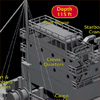 |
|
| Hydro Atlantic • Pompano Beach, Florida |
| Text by Curt Bowen |
| Resting upright on the sandy bottom at 172 feet, the Hydro Atlantic points into the nutrient rich waters of the Gulf Stream. Her deck is still crowded with equipment. Pipes that traverse the old hull from one pump to another. |
|
|
|
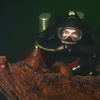 |
|
| Lake Union - Wreck Diving in the Center of a Northwest Metropolis |
Editorial by Chris Borgen and Dan Warter
Photos by Chris Borgen |
| The hearty divers spearheading the Lake Union archeology project are from a non-profit group called the Maritime Documentation Society. At least once a week, Chris Borgen, Erik Foreman, and Dan Warter can be found meeting along the shores of Lake Union, gearing up in closed-circuit rebreathers searching for a “new” wreck. |
|
|
|
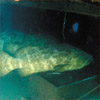 |
|
| Mexican Pride - Gulf of Mexico |
| Text and photography by Curt Bowen |
| One of the more popular wrecks off the shores of Tampa Bay is that of the Mexican Pride. The Pride, as locals call it, is a 200-foot-long bulk-products barge that once transported phosphate out of Tampa Bay. In the 1970’s, the ship fell victim to mismanagement and subsequently was neglected to the point of no return. |
|
|
|
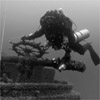 |
|
| Presque Isle - A Shipwreck Extravaganza |
Text and photography by Mel Clark
|
| As we descended on the bow the ships main anchor is standing in the sand below the bow as if holding the great ship in place. I watch as my six foot buddy is dwarfed by the anchor which must be over twenty feet tall . Off the port bow is the pilot house with the ships large double wheel still very much intact. |
|
|
|
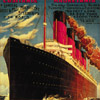 |
|
| Return to Lusitania |
| Text and photography by Leigh Bishop |
| Lusitania is a name well known in the world of wreck diving, often referred to by the technical community as the "ultimate of all wreck dives." For decades historians have been baffled by the endless mysteries locked deep within the Celtic Sea. |
|
|
|
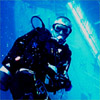 |
|
| Ships to Reefs |
| Article by Harvey Schmiedeke |
| The simple “science” of reefing is really nature’s way of recycling. Put a ship (or any object with a positive electrical charge) in the ocean (seawater has a negative charge) and the magic happens. |
|
|
|
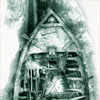 |
|
| Shipwreck Photo Mosaics |
By Tamara Thomsen and Keith Meverden
|
| Using digital video rather than a still camera maximizes productivity during limited bottom times, allowing the capture of literally hundreds of images in a matter of minutes while traveling over the site at a consistent depth and speed, freeing the diver from stopping every few feet to ensure adequate image overlap. |
|
|
|
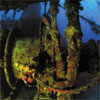 |
|
| SS Curb |
| Article and Photography by Curt Bowen |
| The USS Curb was built in Napa, California, by the Basalt Rock Company, and was commissioned as a Diver Class salvage boat for towing and salvage work in the Atlantic during World War II. |
|
|
|
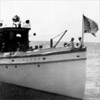 |
|
| SS Tahoe - The Mile High Challenge! |
| By Martin McClellan |
| Located 6,229 feet above sea level in the Sierra Nevada Mountains, Lake Tahoe holds a challenging adventure deep below the surface. Situated comfortably more than 400 feet deep lies the shipwreck of the Steamship Tahoe. Scuttled in 1940, the ship rests on a 30-degree slope. Her bow is at 365 feet and stern at 475 — all of which is protected by frigid 39-degree water. |
|
|
|
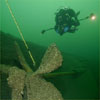 |
|
| The Curse of Lake Erie |
| Text and Photography by Vlada Dekina |
| She sank in 1930 in a squall that first caused her to list to one side and then roll completely upside down before sinking. I got to dive her in 2006, and could barely believe it when I experienced absolutely no problems on that dive. |
|
|
|
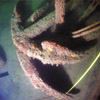 |
|
| The Mystery Anchors - Wreck of John M Osborne |
| by Vlada Dekina |
| It cannot be done…impossible… they would have to break the bow to get them out… they cannot be there just for decoration, could they? These and other perplexing thoughts raced though my brain as I was reviewing my pictures of the anchors proudly attached to the bow of the shipwreck John M. Osborne. |
|
|
|
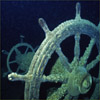 |
|
| The New Tech-Diving Mecca of the Great Lakes |
| Text by Valerie van Heest |
| Over the last decade, Michigan Shipwreck Research Associates, working with shipwreck hunter David Trotter and author/explorer Clive Cussler, has located more than a dozen new deep-water shipwrecks in southeastern Lake Michigan. |
|
|
|
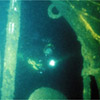 |
|
| The Steam Barges of Whitefish Point |
| By Robert and Jan Underhill |
| The first steam barge, the R. J. Hackett, was built by Eli Peck of Cleveland in 1869. The Hackett was a wooden vessel, 211 feet long, with the pilothouse forward, single engine aft driving a single propeller and a long open deck with large hatches spaced to match for unloading machinery then in use at the ore docks along the Lakes. |
|
|
|
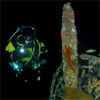 |
|
| The Sunken Goose |
| By Joseph C. Dovala |
| The sun was still high in the California sky as the Grumman Goose Flying Boat revved up for take-off. Onboard were four men, three passengers and the pilot, heading back to the mainland from Avalon, Catalina Island, on September 17, 1979. Conditions were calm, but as the old workhorse reached take-off speed, something gave way and they lost all power. |
|
|
|
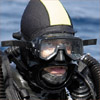 |
|
| The Wreck of the William Dawes |
| Text and Photography by Richard Harris |
| The second deepest wreck ever dived off the Australian coast, the Dawes has been visited on only three previous occasions. Those dives by our group and the Sydney Project team had been plagued with difficulties, and had added little to the knowledge of the wreck. |
|
|
|
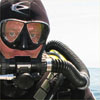 |
|
| Tightrope Walker • WWII's Last Mystery |
Text by ADM staff photojournalist Jeff Toorish • Photos by Jeff Toorish and Rick Marshall
|
What we do know is that Unterseeboot 853 is the last German U-boat sunk in a naval battle off the coast of the US.
|
|
|
|
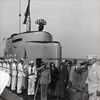 |
|
| U-2513 The first True Modern Submarine |
Text and Photography by Michael C. Barnette
|
| The U-2513 was built in late 1944 at the Blohm and Voss shipyard in Hamburg, Germany. The Type XXI program implemented a fairly efficient modular construction process. Each electroboat was constructed from eight separate sections, allowing the vessels to be completed in approximately six months, including only 50 days on the rails. |
|
|
|
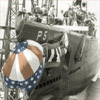 |
|
| USS Perch SS-176 - On Eternal Patrol |
| Text and Photography by Kevin Denlay |
| “It’s a submarine, try to identify it”. Those few words shouted by Vidar Skoglie as he momentarily broke decompression to alert the dive team electrified the dive deck. What was transpiring as just another dive to check out just another mark suddenly became an exciting dive of discovery! |
|
|
|
 |
|
| Wreck of the Illinois - The Propaganda Stunt |
| Text and photography by Vic Verlinden |
| The captain watched the approaching ship through the periscope. He could see very clearly the giant white letters on the side that indicated the name and the nationality of the vessel. Nevertheless, Saltzwedel decided to attack |
|
|
|
| |
| |